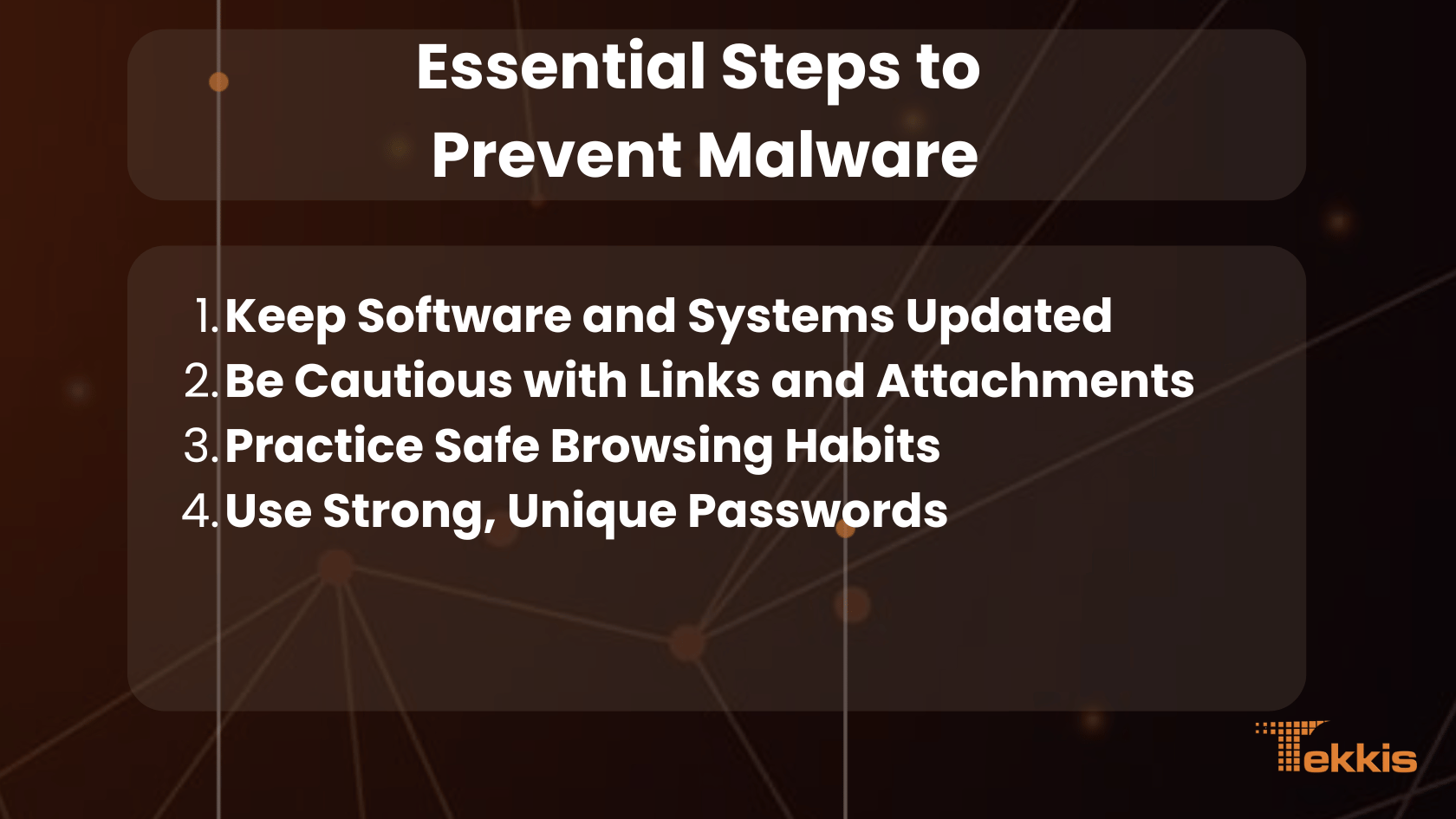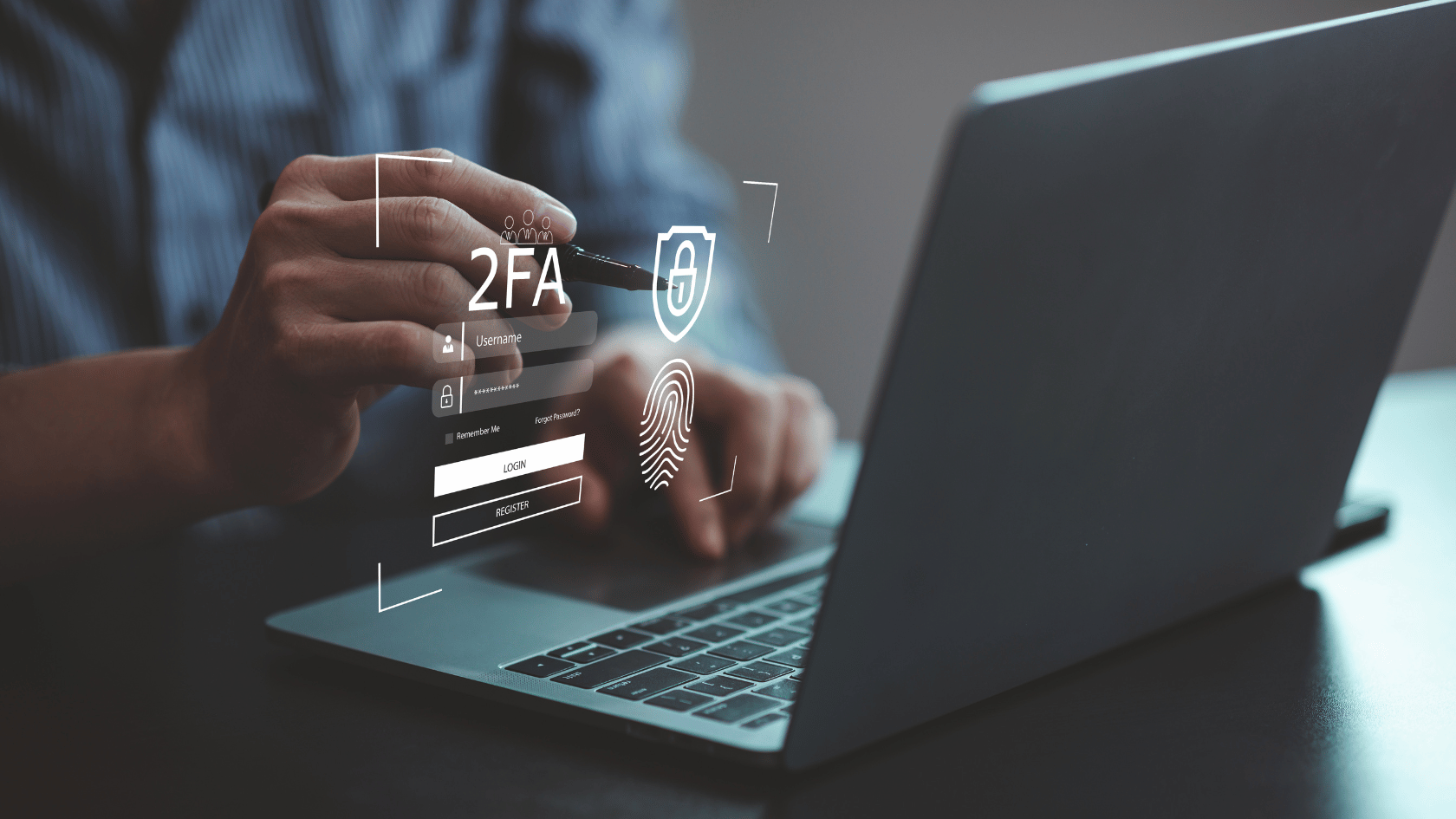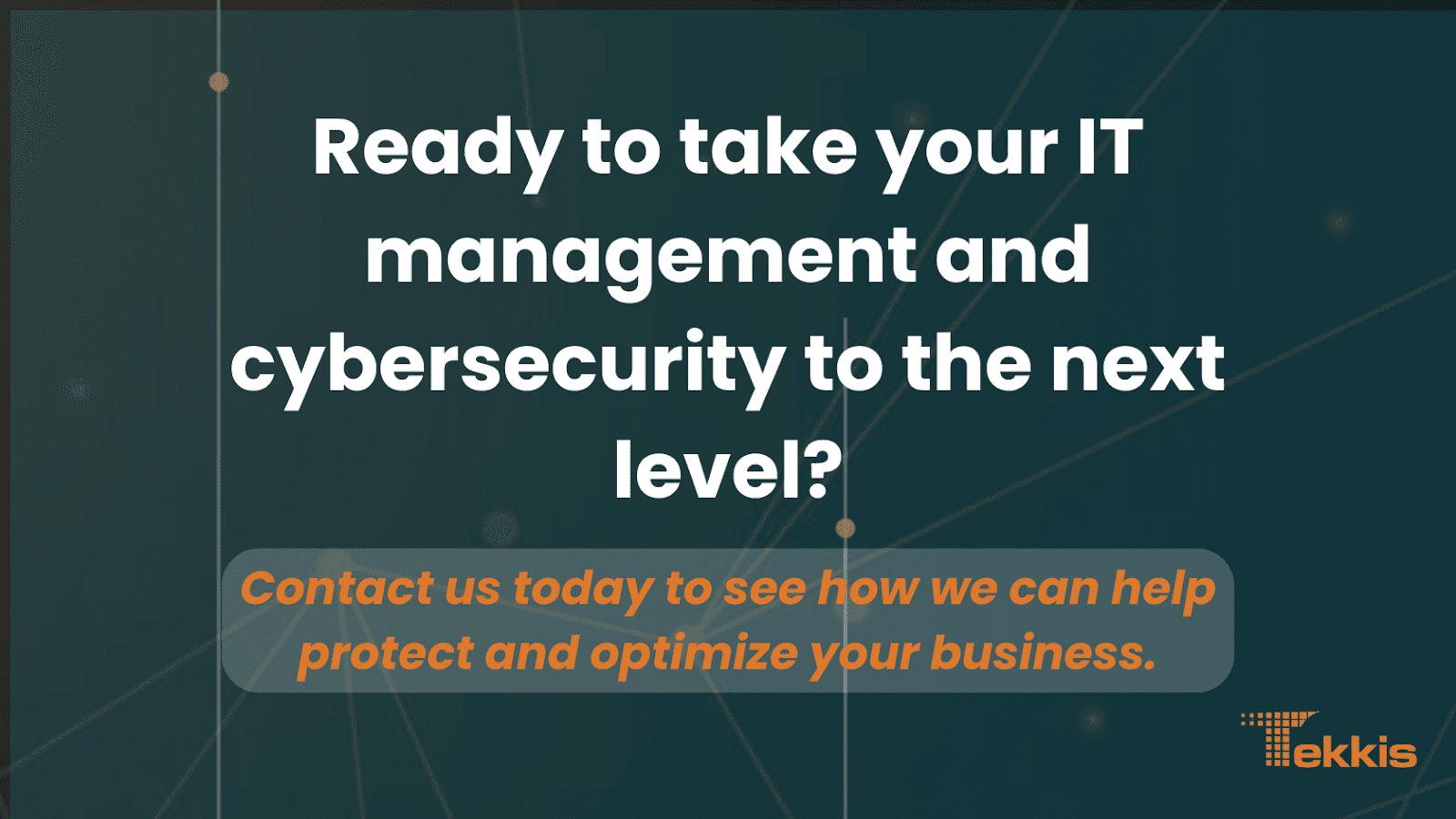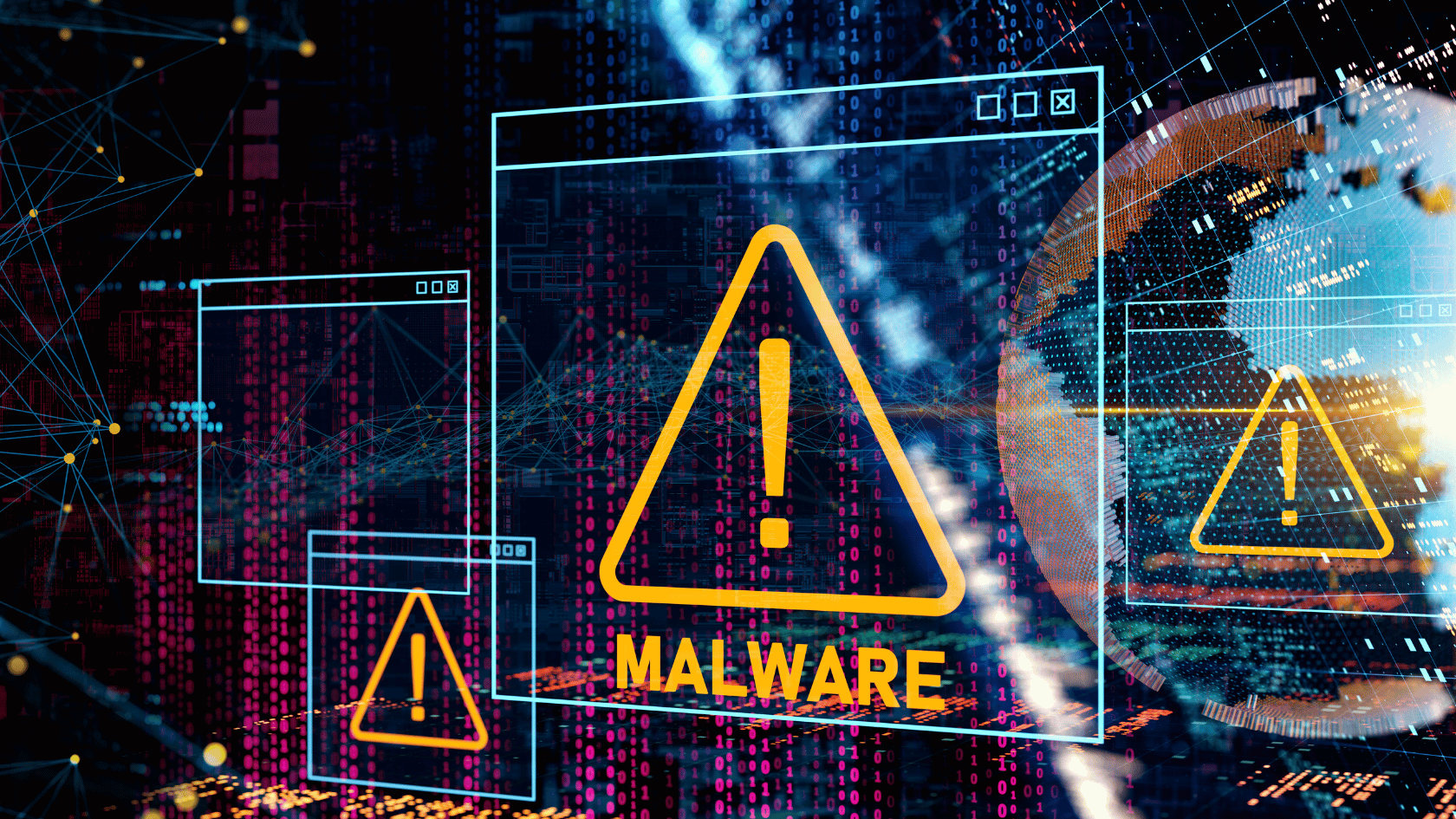How to Prevent Malware
The digital world faces an ever-growing malware threat. With 560,000 new pieces of malware popping up every day, keeping your digital assets safe is crucial. Whether you're browsing the web at home or running a business, knowing how to shield yourself from malware attacks has become as important as locking your front door.
Don’t leave your security to chance—partner with Tekkis Cybersecurity to safeguard your digital presence. Visit our website today to learn how we can help protect you from malware.

What Is Malware? Types and Examples
Think of malware as the digital equivalent of a virus in the real world—it's any software designed to harm your computer, network, or personal data. Trojans make up 58% of all computer malware, sneaking into your system disguised as legitimate programs.
The malware family includes several troublemakers: viruses that spread by copying themselves, worms that crawl through networks on their own, and ransomware—which has become a major headache, showing up in 27% of serious cyber attacks in 2023. Then there's spyware and adware, which either steal your information or bombard you with unwanted ads.
How Malware Infects Systems
Malware is sneaky and uses various tricks to get into your system. Think of it like a burglar who might try the front door, windows, or even dig a tunnel—malware similarly uses multiple ways to break in. Email attachments are still one of the favorite tools, with scammers creating increasingly convincing fake emails to trick you into downloading nasty files.
Sometimes, just visiting the wrong website can trigger an automatic download of malicious code—these are called drive-by downloads. USB drives can be carriers too, and software weak spots act like unlocked windows that malware can slip through.
What makes modern malware particularly tricky is its ability to attack from multiple angles at once. Once it's in, it often digs in deep by changing system files, creating secret entrances, or hiding inside programs you trust. This makes it really hard to find and remove, which is why keeping it out in the first place is so important.
Recognizing Malware Threats
Spotting malware early can save you from a world of trouble. As these digital threats get smarter, knowing what to look for becomes even more important.
Common Malware Vectors
Cybercriminals are creative in spreading malware. Phishing emails remain their favorite trick—these are those deceptive messages that look like they're from your bank or a trusted friend, but actually contain dangerous attachments or links.
They're also getting better at playing mind games. Some might leave infected USB drives in parking lots, knowing someone will plug them in out of curiosity. Even websites you trust can accidentally serve up malware if they've been hacked.
Signs Your Device Might Be Infected
Just like a cold gives you symptoms, malware often shows signs when it's present. If your computer's running slower than molasses or crashing more often than usual, it might be fighting a malware infection.
Random pop-up ads appearing out of nowhere? That's another red flag, especially if they show up when you're not even browsing the internet. Keep an eye on your network activity too—if your device is eating up data while sitting idle, it might be sending your information to hackers or helping them attack others.
Watch out for these warning signs:
- Your browser's homepage changes without your permission
- Programs start up on their own
- Your antivirus software stops working
- Weird error messages or graphics glitches appear
If you notice any of these signs, don't wait—run a thorough malware scan and get expert help if needed.

Essential Steps to Prevent Malware
Keeping malware at bay requires a multi-layered defense strategy. Think of it like protecting your house—you need good locks on the doors, secure windows, and maybe an alarm system too. Let's break down the key steps to keep your digital space safe.
Keep Software and Systems Updated
One of the simplest yet most powerful ways to protect yourself is keeping your software up to date. Those update notifications might seem annoying, but they often contain crucial security fixes. It's like patching holes in your fence before intruders can use them.
Turn on automatic updates whenever you can, especially for your operating system and security software. Don't forget about your browsers, plugins, and other programs too—they all need regular updates to stay secure.
Be Cautious with Links and Attachments
Email safety is crucial in preventing malware attacks. Before clicking any link or downloading attachments, ask yourself: "Was I expecting this?" Even if an email seems to come from someone you know, take a moment to verify—hackers are good at impersonating people.
Be especially wary of files ending in .exe, .vbs, or .scr. If you're unsure about an email, reach out to the sender through another channel, like a phone call, to confirm they actually sent it.
Practice Safe Browsing Habits
Think of safe browsing like driving—stay on the main roads (reputable websites) and watch for warning signs. Look for the padlock icon (HTTPS) in your browser's address bar, especially when sharing sensitive information or making purchases.
Don't let flashy pop-ups or too-good-to-be-true offers tempt you. These are often like digital candy from strangers—attractive but potentially dangerous. Stick to trusted sources for downloading software and making online purchases.
Use Strong, Unique Passwords
Strong passwords are your digital keys—make them count. Mix uppercase and lowercase letters, numbers, and special characters, but more importantly, use different passwords for different accounts. Think about it: if someone gets one key, you don't want them to access everything you own.
A password manager can be your best friend here. It's like having a secure vault that creates and remembers complex passwords for you. Plus, whenever possible, add two-factor authentication—it's like having a second lock on your door.
Enhancing Organizational Defenses
For organizations, protecting against malware is like securing a small city rather than just a house. You need everyone working together, from the security guards to the residents, to keep things safe.
Educating Employees on Cybersecurity
Your team can be either your biggest security weakness or your strongest defense—it all depends on training. Instead of boring presentations, try hands-on workshops where people can practice spotting threats safely.
Quick, regular training sessions work better than long, occasional ones. Think of them like fire drills—short, focused, and practical. Running fake phishing tests can be especially helpful, showing employees what real threats look like without any actual risk.
Regular Security Audits and Vulnerability Assessments
Think of security audits like regular health check-ups for your organization's digital systems. They help catch problems before they become serious. Aim to do big security reviews every quarter, with more frequent checks on your most important systems.
Your security check-ups should cover:
- Network security and protection systems
- Who can access what and how
- Whether software updates are current
- How well security policies actually work
Backup Strategies and Data Recovery
Having good backups is like having insurance—you hope you never need it, but you're grateful when you do. Follow the 3-2-1 rule: keep three copies of your important data, store them on two different types of storage, and keep one copy somewhere else.
Test your backups regularly—there's nothing worse than finding out they don't work when you really need them. Consider using automatic backup systems to make the process foolproof, and keep some backups completely disconnected from your network to protect against ransomware.

Dealing with a Malware Infection
When malware breaks through your defenses, you need to act fast but smart. Here's how to handle an infection effectively.
Detecting an Infection: Tools and Techniques
Modern antivirus tools work like sophisticated security cameras, watching for both known threats and suspicious behavior. They don't just look for known malware signatures—they analyze how programs behave to catch new threats.
The best detection systems use artificial intelligence and safe testing environments to check suspicious files without risking your system. Combine regular scans with real-time monitoring for the best protection.
Isolating and Containing the Threat
If you find malware, your first move should be like quarantining a sick patient—disconnect the infected device from all networks immediately. This stops the malware from spreading or stealing your data.
Then change your passwords and temporarily restrict network access. If you're part of an organization with a segmented network, this is when that setup really pays off—you can contain the problem to one area while keeping everything else running.
Thorough Removal with Professional Guidance
Getting rid of malware is like removing a tough stain—you need the right tools and sometimes professional help. While security software can handle many threats, complex infections often need expert attention. A pro can:
- Find and remove all traces of malware
- Fix any damage to your system
- Set up better protection against future attacks
- Keep records of what happened and how to prevent it
Use multiple security tools for scanning, as some malware can hide from certain programs. After cleanup, watch your system closely for any lingering issues, and restore your data from clean backups only after you're sure the threat is gone.

Conclusion: Building a Resilient Cybersecurity Posture
Protecting against malware isn't about finding one perfect solution—it's about building layers of defense. Like a medieval castle with its moat, walls, and guards, good security combines multiple protective measures.
The threat landscape keeps changing, with new malware appearing daily. Success in cybersecurity means staying informed, staying alert, and adapting your defenses as threats evolve. Regular updates, solid backup plans, and ongoing training are your foundation for strong security.
Remember that cybersecurity is an ongoing process, not a one-time fix. By using the strategies we've discussed and staying committed to security best practices, you'll be much better protected against malware attacks. The time and effort you invest in security today will save you from bigger headaches tomorrow.
Take action now! Reach out to Tekkis Cybersecurity to strengthen your defenses and safeguard your valuable data. Don’t wait for a breach to happen—partner with us and stay one step ahead of potential threats.



